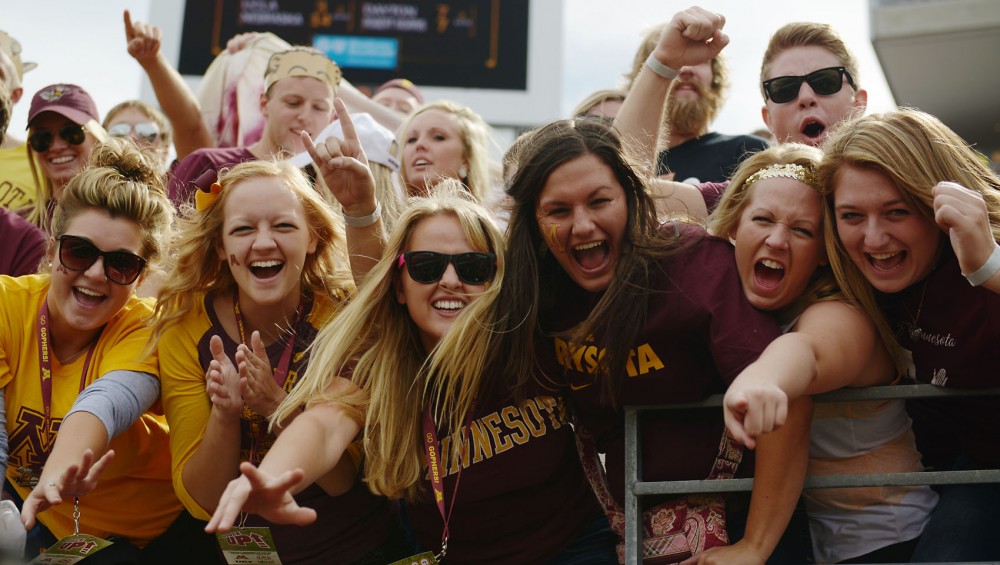The 2013 homecoming football game between Iowa and Minnesota drew a record crowd at TCF Bank Stadium.
But recent attendance numbers at home games suggest the record draw may have been a fluke.
Fan attendance at Gophers home football games has decreased every year since TCF Bank Stadium opened in 2009. And at the current rate, the 2013 season will continue that downward trend.
All seven home games were sold out during TCF Bank Stadium’s inaugural season. Since then, the stadium has only sold out three times in three and a half seasons.
Though many fans have contributed to the drop in attendance, marketing senior Tyler Othen said he’s noticed a dwindling number of students attending games lately.
Othen has held season tickets every year he’s attended the University, and he said student attendance this season is the worst he’s ever seen.
“Homecoming is one thing,” he said. “But with some upcoming games, you kind of forget about them because you don’t hear about it.”
Othen said he thinks Minnesota’s struggles on the field have had the biggest impact on student attendance. The Gophers are 9-25 in Big Ten games since TCF Bank Stadium opened.
In addition to the team’s poor play over the years, Othen said the cold Minnesota weather keeps even more students away from games late in the season.
“People sometimes view [football] as a warm-weather, social event,” he said. “When it starts to get cold, there’s barely anyone in the stands.”
A national trend
Still, Minnesota’s student section isn’t the only fan base with shrinking numbers.
Student attendance is declining nationwide, according to a recent Wall Street Journal report. Even perennial powerhouses like Georgia and Alabama sometimes find it difficult to get students to come to games.
University of Tennessee political science senior Tanner Beck said student attendance has declined at his school in the past 10 years because the team has underachieved.
Although a respectable number of people still come to games, he said, the team’s struggles have had a significant impact on attendance.
“I don’t think it’s gone down because of disinterest in football,” he said. “It goes down when your team doesn’t perform as well as people expect.”
While poor performance can have a negative effect on attendance, success on the field can have a positive effect.
University of Oklahoma business and supply chain management senior Briana Coghlan said her school’s student section always seems full.
“The University tries to get us to go to volleyball games,” she said. “They’re not worried about getting us into football.”
Coghlan pointed out that many Oklahoma fans even make an annual trip to Dallas to watch the rivalry game with Texas. The school cancels classes the Friday before the game.
“Our ‘fall break’ is to go to that game,” she said. “I know maybe five people who aren’t going to Dallas.”
UCLA cognitive science and sociology junior Ben Bordofsky said he’s seen an increase in attendance at football games this season.
The Bruins improved their record from 6-8 in 2011 to 9-5 last season, which Bordofsky said helped bring more fans to the games.
“I personally wasn’t too interested in going to games before,” he said. “But starting last year, I think people are starting to get more excited about football.”
Campus unity
Last season, the Gophers finished with a 6-7 record despite winning the first four games of the season.
Once Minnesota started losing, fans stopped coming to games.
The best way to boost fan attendance at Minnesota is to change the culture around the football program, Othen said.
“It’s a little bit of a bandwagon effect,” he said. “Later [in the season], there’s this lack of team spirit.”
That isn’t a problem at schools like Oklahoma and Florida State, which have strong football traditions.
“OU is synonymous with football,” Coghlan said. “The administration doesn’t have to market football at all.”
Florida State media production senior David Swinburne said his university shuts down when the football team plays.
“They close down the streets around the school,” he said. “You can find a tailgate anywhere within four miles of the school.”
It’s that feeling of campus unity that Minnesota lacks, Othen said. While winning more games will help, he said, it’s up to the students to commit to supporting the team through good times and bad.
“The stadium should fill up,” Othen said. “There needs to be some kind of centralized feeling, something that can bring a campus together.”


